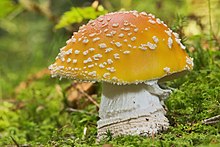Agaricomycetes
| Agaricomycetes Temporal range:
| |
|---|---|

| |
| Amanita muscaria (Agaricales) | |
| Scientific classification | |
| Domain: | Eukaryota |
| Kingdom: | Fungi |
| Division: | Basidiomycota |
| Subdivision: | Agaricomycotina |
| Class: | Agaricomycetes Doweld (2001)[1] |
| Subclasses/orders | |
incertae sedis (no subclass)
| |
The Agaricomycetes are a
Classification
Although
Features
All members of the class produce basidiocarps which range in size from tiny cups a few millimeters across to a giant polypore (Phellinus ellipsoideus) greater than several meters across and weigh up to 500 kilograms (1,100 lb).[9] The group also includes what are arguably the largest and oldest individual organisms on earth: the mycelium of one individual Armillaria gallica has been estimated to extend over 15 hectares (37 acres) with a mass of 10,000 kilograms (22,000 pounds) and an age of 1,500 years.[10]
Ecology
Nearly all species are terrestrial (a few are aquatic), occurring in a wide range of environments where most function as decayers, especially of wood. However, some species are
Evolution
A study of 5,284 species with a backbone phylogeny based on 104 genomes[11] has suggested the following dates of evolution:
Agaricomycetidae ~185 million years ago (174 million years ago–192 million years ago)
Cantharellales 184 million years ago (144 million years ago–261 million years ago)
Agaricales 173 million years ago (160 million years ago-182 million years ago)
Hymenochaetales 167 million years ago (130 million years ago–180 million years ago)
Boletales 142 million years ago (133 million years ago–153 million years ago)
Fossil record
The fruit bodies of Agaricomycetes are extremely rare in the
Phylogeny
Modern molecular phylogenetics suggest the following relationships:[15]
| |||||||||||||
Genera incertae sedis
There are many genera in the Agaricomycetes that have not been classified in any order or family. These include:
- Akenomyces
- Aldridgea
- Anixia
- Arrasia[16]
- Arthrodochium
- Arualis
- Atraporiella
- Cenangiomyces
- Ceraceopsis
- Corticomyces
- Cruciger
- Dendrosporomyces
- Ellula
- Fibulochlamys
- Fibulocoela
- Fibulotaeniella
- Geotrichopsis[17]
- Gloeoradulum
- Gloeosynnema
- Glomerulomyces
- Glutinoagger
- Grandinia
- Granulocystis
- Hallenbergia
- Hyphobasidiofera
- Hypolyssus
- Intextomyces
- Korupella
- Minostroscyta[18]
- Mylittopsis
- Odonticium
- Pagidospora
- Peniophorella
- Phlyctibasidium
- Pseudasterodon
- Purpureocorticium S.H.Wu (2017)[19]
- Pycnovellomyces
- Resinicium
- Riessia
- Riessiella
- Skvortzovia
- Taiwanoporia[20]
- Timgrovea
- Titaeella
- Trechinothus
- Tricladiomyces
- Trimitiella
- Tubulicrinopsis
- Xanthoporus
- Xenosoma
References
- ISBN 978-5-89118-283-7.
- ^ Hibbett DS, Thorn RG (2001). McLaughlin DJ, et al. (eds.). The Mycota, Vol. VII. Part B., Systematics and Evolution. Berlin, Germany: Springer-Verlag. pp. 121–168.
- S2CID 4686378.
- ISBN 978-0-85199-826-8.
- S2CID 23931256.
- PMID 24777067.

- S2CID 17382765.
- ^ Fries EM (1874). Hymenomycetes Europaei (in Latin). Uppsala: Typis Descripsit Ed. Berling. p. 1.
- PMID 21872178.
- S2CID 4319556.
- PMID 30886374.
- .
- PMID 21148842.
- S2CID 37121590.
- ISBN 978-3-642-55317-2.
- doi:10.5248/118.257. Archived from the original(PDF) on 2021-03-29. Retrieved 2016-10-07.
- .
- ^ Hjortstam, Kurt; Ryvarden, Leif (2001). "Corticioid species (Basidiomycotina, Aphyllophorales) from Colombia III". Mycotaxon. 79: 189–200.
- S2CID 3319380.
- S2CID 49434.
